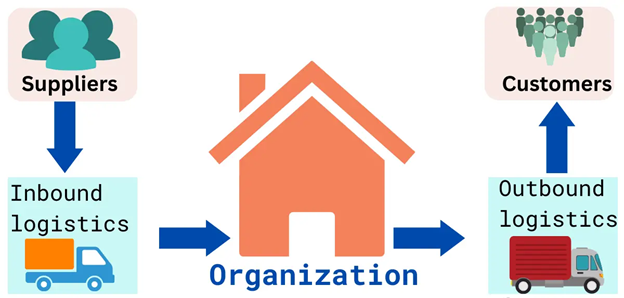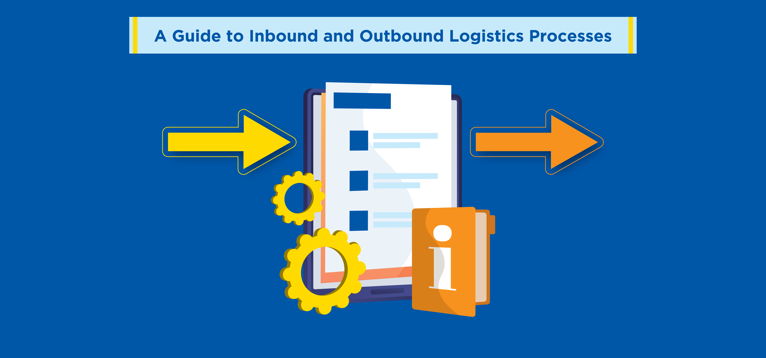There’s no denying that efficient logistics is critical to the smooth operations of the supply chain.
But within logistics, there are functions that businesses need to pay heed to as they enable fast and efficient delivery of goods and ultimately meet customer expectations.
These functions are inbound and outbound logistics.
While it is the movement of goods that differentiates both these concepts, they need to work in sync to create a better supply chain and achieve success in overall logistics management.
What is Inbound Logistics?
When you source goods into the supply chain, it’s known as inbound logistics. It includes the process of inward movement of raw materials, goods from suppliers, or unfinished products.
It means sourcing all the materials into a facility where the unit would manufacture commodities out of them and build a finished product that will ultimately be sold to the end consumer.
What is Outbound Logistics?
Outbound logistics involves the process after they’re manufactured and moving the goods outside the supply chain. It includes storing, moving, and distributing goods to deliver them to their final destination.
If the process involves order confirmation, order fulfilment, shipping, last-mile delivery, customer service, etc, they fall into the category of outbound logistics.
What is the Difference Between Inbound and Outbound Logistics?
While both inbound and outbound logistics fall under the bigger umbrella of logistics, the primary difference lies in their movements.

This difference births other differences in terms of functions, activities, and relationship management within the supply chain management. Let’s take a look at the difference between inbound and outbound logistics in detail.
| Inbound Logistics | Outbound Logistics | |
|
Meaning |
The influx of raw materials and inventory into a business’s manufacturing facility is called inbound logistics. | It is the process of the outflow of finished products to the customers. |
| Processes | Sourcing of raw materials Warehouse receiving Storage of materials Inventory management Delivery of raw materials |
Order confirmation Packaging of finished goods Shipping and last-mile delivery Customer Service |
| Relationships | The focus is on the relationship with the suppliers. | The focus is on the relationship with customers. |
| Examples | For example, for manufacturing a car, inbound logistics requires sourcing raw materials like metal, paint, engine, etc. and assembling them into the manufacturing unit. | Outbound logistics would mean transporting the manufactured car to the retail showrooms for final purchases. |
What are Inbound and Outbound Logistics Processes?
Inbound Logistics Process
1. Sourcing of Raw Materials
The first process in inbound logistics is to source materials or products. This means choosing suppliers and vendors for raw materials, getting price estimates for the same, and negotiating with suppliers.
2. Purchasing Materials
After you select the suppliers, you make an order for purchasing materials from them. And while you’re at it, just ensure that you keep a track record of the goods purchased and have the logistics decided.
3. Delivery of Raw Materials
After the order is confirmed, the supplier is responsible for manufacturing the required materials to the business’s warehouse unit, distribution centre, or manufacturing facility.
This is usually done by freight service providers as they’re the best judge on which transport mode to choose and what would be the quickest route.
4. Receiving and Storage of Materials
Once the goods arrive at the order fulfilment centre, the warehouse is responsible for unloading the cargo and receiving the goods.
The warehouse team also logs in the records and counts the goods to ensure the number of goods ordered and the number of goods received are matching. The goods are then stored in the warehouse until the outbound logistics process is initiated.
Outbound Logistics Process
1. Order Processing
The process of outbound logistics starts as soon as the customer places an order. The order finds itself in an order management system and is sorted to the appropriate warehouse that will fulfil the order.
2. Order Packaging
Once the order is processed, it needs to be picked up from the assigned warehouse. They’re packed into boxes or mailers, labelled with shipping details, and sorted by the shipping provider.
3. Shipping and Last-mile Delivery
The product is then shipped to the end customer. eCommerce companies and other industries usually rely on 3PL providers to pick up the packages from the warehouse, optimize the routes, and use the best shipping method to deliver the goods.
4. Customer Service
Outbound logistics also include providing customers with top-notch delivery services such as order tracking and providing real-time information about order status, etc. The logistics provider should be able to communicate efficiently with customers and handle problems arising from the fulfilment or shipping process.
Challenges of Inbound and Outbound Logistics
1. Increased Costs
Logistics has long been an irreplaceable expense for most companies. If the inbound and outbound logistics costs are not optimized, it can become extremely challenging for companies to control their costs.
2. Inefficient Operations
There are a lot of factors that can go wrong in both inbound and outbound logistics. The inventory data can be inaccurate, the workforce may not be experienced, there’s a high amount of wastage, and the materials aren’t handled properly. The list goes on. The idea is to work on these issues from the beginning to avoid issues in the logistics processes later on.
3. Lack of Data
Data makes the core of inventory and warehouse management processes today. If businesses don’t have tools that gather data, managing inbound and outbound logistics manually can become a nightmare.
4. Quality Issues
Since you rely immensely on suppliers for quality checks, there are always chances of procurement errors. It makes it essential to have multiple quality checks to ensure the best product qualities before they're delivered to the customer.
Wrapping Up
Inbound and outbound logistics is no cakewalk. You need experts who can optimize and manage these processes for you so that your delivery needs are met at an optimized cost.
Without further ado, you can contact us at PACK & SEND for your logistics requirements. As an experienced 3PL provider, you can rely on us to fulfil your supply chain objectives with ease and perfection.
Image Source: erp-information.com
